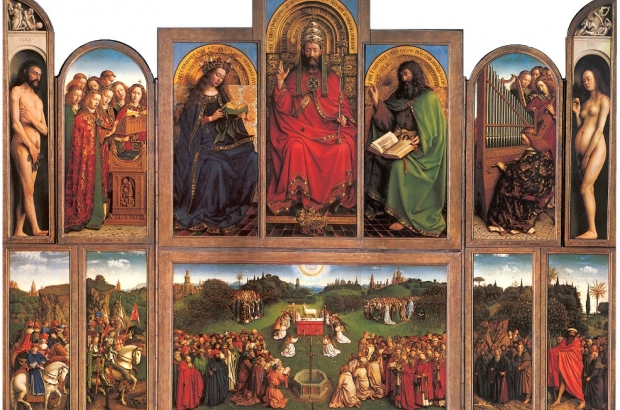- Daily & Weekly newsletters
- Buy & download The Bulletin
- Comment on our articles
Missing panel of Ghent Altarpiece possibly found
One of the most enduring criminal mysteries in Flanders, and the longest-running investigation on the books of the Ghent prosecutors’ office, could be nearing a solution, according to a Flemish historian. The panel known as “De rechvaardige rechters”, or “The Righteous Judges”, from the Ghent Altarpiece has been missing since it was stolen in 1934. A local historian now says he knows where it is.
Jan and Hubert Van Eyck painted “Het Lam Gods”, known in English as “The Adoration of the Mystic Lamb” or simply the Ghent Altarpiece, in 1432 for a side chapel in the church of Saint John, now Sint-Baaf’s cathedral. It is one of the world’s first oil paintings and considered a high point in Nederlandish art.
The altarpiece contains 20 double-sided panels and hinges that allow it to be closed. When open, it reveals a triptych showing on one level God, flanked by the Virgin and the Baptist, as well as singing angels and Adam and Eve after their expulsion from the Garden. On the lower level, the work shows the Lamb of God on an altar, surrounded by martyrs, prophets and saints, knights and judges. When closed, the work depicts the scene of the Annunciation as prophets and Sybils look on.
In April of 1934, two panels from the work were stolen in an attempt to extort money from the Bishop of Ghent. One of the panels was returned as proof that the thieves were serious, and the other, depicting the Righteous Judges (below, far left in photo), has been missing ever since. Aside from being part of one of the world’s most valuable oil paintings, the panel is thought to include portraits of the Van Eyck brothers themselves.
A copy was added to the altarpiece, but the missing panel has remained one of the most intriguing mysteries in European art. Amateur and professional detectives have tried and failed to track down the missing panel for 80 years.
This weekend, Paul De Ridder, a historian and member of the Brussels Parliament, told VRT news that he had tracked the work to a “prominent Ghent family”, who have declined to come forward for fear of damaging their good name. De Ridder declined to identify them, but in a similar story reported by De Standaard in 2012, the family was revealed to be that of the former Belgian minister August De Schryver.
Spokesperson Annemie Serlippens of the Ghent prosecutor’s office said they had received a tip as to the whereabouts of the panel last year and began an investigation. A number of members of the family have been interviewed, she said.
De Ridder said he hoped the case could still be resolved by agreement and that he was bringing the case to light to put pressure on the family to co-operate. His appeal was backed by the Bishop of Ghent, Luc Van Looy, who called for the panel to be returned out of respect for the “integrity and totality” of the work.
However, Van Looy admitted that he held out little hope of a positive result. “I consider the chance to be very slim that I will see the panel restored in my lifetime,” he told VTM.


















